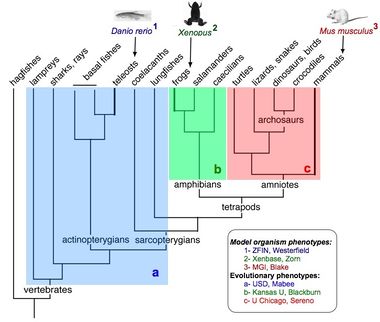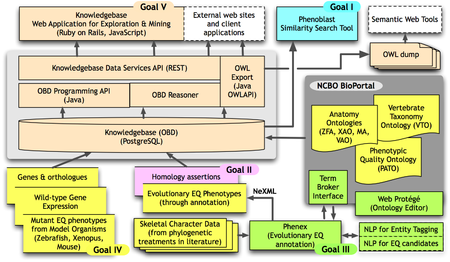Difference between revisions of "Main Page"
Todd Vision (talk | contribs) |
Todd Vision (talk | contribs) |
||
| Line 1: | Line 1: | ||
{{EventBox1| | {{EventBox1| | ||
* '''Try the Beta version of the [http://kb.phenoscape.org Phenoscape Knowledgebase].''' Development is very much in progress, and your feedback is welcome! | * '''Try the Beta version of the [http://kb.phenoscape.org Phenoscape Knowledgebase].''' Development is very much in progress, and your feedback is welcome! | ||
| − | * Check out the latest news on the [http://blog.phenoscape.org/ Phenoscape blog] | + | * Check out the latest news on the [http://blog.phenoscape.org/ Phenoscape blog] |
* Apply to the [https://academy.nescent.org/wiki/Anatomy_ontologies Anatomy Ontology Summer Course], 30-Jul to 3-Aug 2012 at NESCent in Durham, NC. The target audience is postgraduate researchers in evolutionary biology and informatics – including students, postdocs and faculty – who are relative newcomers to ontologies. Application deadline 6-Apr. | * Apply to the [https://academy.nescent.org/wiki/Anatomy_ontologies Anatomy Ontology Summer Course], 30-Jul to 3-Aug 2012 at NESCent in Durham, NC. The target audience is postgraduate researchers in evolutionary biology and informatics – including students, postdocs and faculty – who are relative newcomers to ontologies. Application deadline 6-Apr. | ||
| + | * We are recruiting for a postdoc at NESCent interested in the [[https://docs.google.com/document/d/1CAiXFnzueBliLom_kRBnjDuDOuuRIrPkJ6zZNRBUeQQ application of phenotype bioinformatics to evo-devo]].}} | ||
== Ontology-enabled reasoning across phenotypes from evolution and model organisms == | == Ontology-enabled reasoning across phenotypes from evolution and model organisms == | ||
Revision as of 16:14, 27 February 2012
- Try the Beta version of the Phenoscape Knowledgebase. Development is very much in progress, and your feedback is welcome!
- Check out the latest news on the Phenoscape blog
- Apply to the Anatomy Ontology Summer Course, 30-Jul to 3-Aug 2012 at NESCent in Durham, NC. The target audience is postgraduate researchers in evolutionary biology and informatics – including students, postdocs and faculty – who are relative newcomers to ontologies. Application deadline 6-Apr.
- We are recruiting for a postdoc at NESCent interested in the [application of phenotype bioinformatics to evo-devo].
Contents
Ontology-enabled reasoning across phenotypes from evolution and model organisms
About this project
Our overall objective is to create a scalable infrastructure that enables linking descriptive phenotype observations across different fields of biology by the semantic similarity of their free-text descriptions. In other words, we are trying to make descriptive observations amenable to large-scale computation so that they can be subjected to computational data integration and knowledge discovery techniques in ways similarly powerful as the techniques we are used to for numeric, quantitative observations.
Our approach to accomplish this centers on transforming descriptive observations from the natural language text form in which they are typically reported, to fully computable logic expressions that utilize terms from shared ontologies. We create these expressions (which we also call "annotations") for evolutionary phenotypes reported in the systematics literature, typically in the form of character state matrices. We use the Entity-Quality (EQ) formalism to compose these expressions, which was initially conceived for making biomedical and mutant model organism phenotype observations interoperable.
We combine the EQ annotations we create for evolutionary phenotypes with the EQ annotations created for the myriad of phenotypes observed for mutant model organisms in an integrated knowledgebase (essentially a triple-store). We then apply Description Logic-reasoning to evaluate which evolutionary phenotype transitions can be inferred as semantically similar to which mutant model organism phenotypes, and vice versa. Since the genetic cause of a mutant phenotype is usually known, the links between evolutionary and mutant phenotypes identified in this way can be used to construct testable hypotheses about the genetic correlates or causes of evolutionary transitions.
In a previous project, titled Linking Evolution to Genomics Using Phenotype Ontologies, we developed a working prototype as a successful proof-of-concept, using teleost fishes for evolutionary phenotypes and the zebrafish model organism as a source of mutant phenotypes. Here, we aim to make the components of the prototype, including tools and workflows, sufficiently scalable so that they are adequate for the much more extensive volume and more diverse nature of skeletal phenotypes across all vertebrates, fossil and modern. Specifically, our aims encompass the following:
- Develop a fast semantic similarity engine so that the integrated knowledgebase can be searched on-the-fly for biological taxa or genotypes bearing a profile of phenotypes that is similar, but not necessarily identical, to a query profile.
- Develop an ontological framework for reasoning over homology that can be scaled to a large number of anatomically diverse evolutionary lineages.
- Reduce the time and cost of obtaining EQ statements from the literature, while at the same time improving the quality and consistency of those statements, by incorporating natural language processing tools and by improving curation software to allow for on-demand augmentation of community ontologies.
- Build umbrella taxonomic and anatomical ontologies for the vertebrates, the latter to be supplemented by explicit homology relations among anatomical structures.
- Create a knowledgebase that integrates evolutionary phenotypes for vertebrate fin and limb characters with genetic and phenotype data from three vertebrate model organisms: zebrafish (Danio rerio), frog (Xenopus laevis), and mouse (Mus musculus).
- As a capstone, we will assess the results of our work by how well we can apply machine reasoning to retrieve candidate genes for the well-studied vertebrate fin-limb transition and other major events in skeletal evolution of vertebrates.
In addition to a web-based interface, we will make all data, including the integrated knowledgebase, available in the Web Ontology Language (OWL), so that other researchers can reuse the data in as many ways as possible.
The vertebrate fin/limb transition: the test system
The evolution of limbs from fins is arguably one of the most well studied transitions in vertebrate history. The genes involved in positioning, growth, and patterning of the fin and limb at various stages are well-known and documented in the vertebrate model organism databases ZFIN, Xenbase, and MGI; changes in skeletal morphology and corresponding assertions of homology are well-documented in the comparative morphological literature. Bringing together the genetic, developmental, morphological and evolutionary data in the Phenoscape Knowledgebase will provide an ideal test bed for judging the reliability of candidate gene predictions and the application of homology logic.
Outreach
Outreach activities to include:
- Summer internships in bio-ontologies for undergraduate/graduate students, in partnership with the DeepFin RCN.
- A "Junior Biocurator" program for advanced Chicago public high school students to be implemented by Project Exploration.
- Undergraduate internship and community outreach to the Lakota population through the University of South Dakota.
Contacts
Paula Mabee (University of South Dakota) and Todd Vision (University of North Carolina Chapel Hill, National Evolutionary Synthesis Center) are the Principal Investigators of this project. Co-principal investigators are David Blackburn (California Academy of Sciences), Judith Blake (Mouse Genome Informatics, Jackson Laboratories), Hilmar Lapp (National Evolutionary Synthesis Center), Paul Sereno (University of Chicago), Monte Westerfield (ZFIN, University of Oregon), and Aaron Zorn (Xenbase, Cincinnati Children's Hospital Medical Center) (see their contact addresses).
Acknowledgements
| The Phenoscape project is funded by NSF collaborative grants DBI-1062404 and DBI-1062542 from July 1, 2011, to Jun 30, 2015, and supported by the National Evolutionary Synthesis Center (NESCent), NSF #EF-0905606. The original Project Description for this grant is available here.
This project would not have been possible without the hard work of numerous contributors and the results obtained in the Linking Evolution to Genomics Using Phenotype Ontologies project, which was funded by NSF grant BDI-0641025 from June 1, 2007, to Jun 30, 2011, and was supported by NESCent, NSF #EF-0423641. This earlier project in turn arose from a NESCent Working Group led by Paula Mabee and Monte Westerfield, "Towards an Integrated Database for Fish Evolution." |

|

